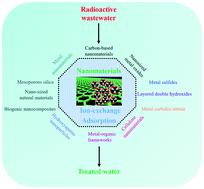当前位置:
X-MOL 学术
›
Environ. Sci.: Nano
›
论文详情
Our official English website, www.x-mol.net, welcomes your
feedback! (Note: you will need to create a separate account there.)
Nanomaterials for radioactive wastewater decontamination
Environmental Science: Nano ( IF 5.8 ) Pub Date : 2020-02-25 , DOI: 10.1039/c9en01341e Xiaoyuan Zhang 1, 2, 3, 4 , Yu Liu 1, 2, 3, 4, 5
Environmental Science: Nano ( IF 5.8 ) Pub Date : 2020-02-25 , DOI: 10.1039/c9en01341e Xiaoyuan Zhang 1, 2, 3, 4 , Yu Liu 1, 2, 3, 4, 5
Affiliation

|
Radioactive waste is a byproduct of nuclear power generation and applications of various radioactive materials in many commercial sectors. This waste has been strictly regulated as a highly hazardous material to all forms of life as well as the environment. The technologies currently adopted for managing radioactive waste are mainly based on segregation and storage. Ideally, radioactive waste should be isolated from entering the environment, but there has been slow progress toward sustainable waste management. Nanomaterials, with unique physical and chemical properties, such as the nanosize effect, large specific surface area, and high reactivity and selectivity, have become new materials for radioactive wastewater decontamination. Therefore, this review aims to provide a comprehensive overview and analysis of a newer generation of nanomaterials that have been demonstrated to be effective for radioactive wastewater decontamination, such as carbon-based nanomaterials, metal nanoparticles, nanosized metal oxides, metal sulfides, nanosized natural materials, layered double hydroxides, hydroxyapatite nanoparticles, metal–organic frameworks, cellulose nanomaterials, and biogenic nanocomposites. Although many different types of nanomaterials have been developed, their engineering feasibility toward radioactive wastewater decontamination has not yet been demonstrated for real-world large-scale applications. Lastly, the challenges associated with the applications of nanomaterials for radioactive wastewater decontamination have been discussed in detail while shedding light on future research directions.
中文翻译:

用于放射性废水净化的纳米材料
放射性废物是核发电和多种放射性材料在许多商业领域中的应用的副产品。该废物已被严格管制为对所有生命形式和环境均具有高度危害性的材料。当前用于管理放射性废物的技术主要基于隔离和存储。理想情况下,应将放射性废物与外界环境隔离开来,但在可持续废物管理方面进展缓慢。具有独特的物理和化学特性的纳米材料,例如纳米尺寸效应,大的比表面积以及高的反应性和选择性,已经成为用于放射性废水净化的新材料。因此,这篇综述旨在对已被证明对放射性废水净化有效的新一代纳米材料进行全面的概述和分析,例如碳基纳米材料,金属纳米颗粒,纳米级金属氧化物,金属硫化物,纳米级天然材料双氢氧化物,羟基磷灰石纳米颗粒,金属有机骨架,纤维素纳米材料和生物纳米复合材料。尽管已经开发了许多不同类型的纳米材料,但是它们在放射性废水净化方面的工程可行性尚未在现实世界的大规模应用中得到证明。最后,
更新日期:2020-02-25
中文翻译:

用于放射性废水净化的纳米材料
放射性废物是核发电和多种放射性材料在许多商业领域中的应用的副产品。该废物已被严格管制为对所有生命形式和环境均具有高度危害性的材料。当前用于管理放射性废物的技术主要基于隔离和存储。理想情况下,应将放射性废物与外界环境隔离开来,但在可持续废物管理方面进展缓慢。具有独特的物理和化学特性的纳米材料,例如纳米尺寸效应,大的比表面积以及高的反应性和选择性,已经成为用于放射性废水净化的新材料。因此,这篇综述旨在对已被证明对放射性废水净化有效的新一代纳米材料进行全面的概述和分析,例如碳基纳米材料,金属纳米颗粒,纳米级金属氧化物,金属硫化物,纳米级天然材料双氢氧化物,羟基磷灰石纳米颗粒,金属有机骨架,纤维素纳米材料和生物纳米复合材料。尽管已经开发了许多不同类型的纳米材料,但是它们在放射性废水净化方面的工程可行性尚未在现实世界的大规模应用中得到证明。最后,











































 京公网安备 11010802027423号
京公网安备 11010802027423号